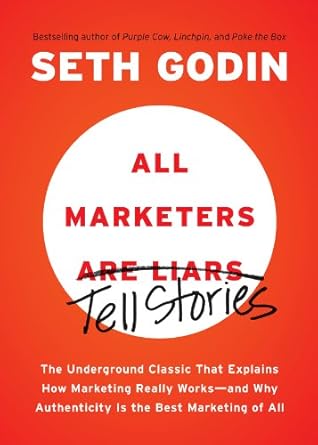More on this book
Community
Kindle Notes & Highlights
by
Seth Godin
Read between
June 17 - July 10, 2021
Don’t try to change someone’s worldview is the strategy smart marketers follow. Don’t try to use facts to prove your case and to insist that people change their biases. You don’t have enough time and you don’t have enough money. Instead, identify a population with a certain worldview, frame your story in terms of that worldview and you win.
Marketing succeeds when enough people with similar worldviews come together in a way that allows marketers to reach them cost-effectively.
Your opportunity lies in finding a neglected worldview, framing your story in a way that this audience will focus on and going from there.
You don’t get to make up the story. The story happens with or without you. If you’re not happy with the story, the only way to change it is with direct contact between your consumer and a person.
BEFORE I TELL SOMEONE A STORY, I TELL THAT STORY TO MYSELF
I believe the best way to do that is to craft a story that someone enjoys telling to himself. Before we are able to share a story with friends, colleagues or the Internet, we need to tell it to ourselves.
once fooled, a person will never repeat your story to someone else.
People don’t want to change their minds.
Vivian is growing by reaching out to communities that will choose to pay attention, to individuals who have a worldview that will embrace the story she’s trying to tell.
The assumption (a correct one) is that people notice a discount card if it’s given to them by someone they trust.
Vivian will really have a home run once her loyal customers start telling stories to their friends—friends who might not share the worldview but are eager to do something that others are doing, eager to hang out at a place beloved by their best friends.
Some senses count for more than others, but every sense matters.
You win when you manage to make your story coherent.
If you are able to live the story you want to tell, the people you’re telling it to are more likely to believe it because you’ll get all the details right.
The problem is that once a consumer has bought someone else’s story and believes that lie, persuading the consumer to switch is the same as persuading him to admit he was wrong. And people hate admitting that they’re wrong.
Instead, you must tell a different story and persuade those listening that your story is more important than the story they currently believe.
The best strategy would have been to go first. Failing that, the appropriate response would have to been to tell a completely different story, one that used a frame that matched the worldview of the undecided voter.
But it’s also certain that addressing the community of your dominant competitor is going to fail.
In order to grow, you can’t tell the same story to the same people (even if you tell it louder or with more style). Instead you will find success by telling a different story to part of the community with a particular worldview that’s different from that of the masses.
The only stories that work, the only stories with impact, the only stories that spread are the “I can’t believe that!” stories. These are the stories that aren’t just repeatable: these are the stories that demand to be repeated.
You succeed by being an extremist in your storytelling, then gracefully moving your product or service to the middle so it becomes more palatable to audiences that are persuaded by their friends, not by you.
Your goal should not (must not) be to create a story that is quick, involves no risks and is without controversy. Boredom will not help you grow.
“A piece of art is not a loaf of bread. When someone steals a loaf of bread from the store, that’s it. The loaf of bread is gone. When someone downloads a piece of music, it’s only data until the listener puts that music back together with their own ears, their mind, their subjective experience. How they perceive your work changes your work. Treating your audience like thieves is absurd. Anyone who chooses to listen to our music is a collaborator.”
Remember, the marketer tells a story. The consumer believes it and it becomes a lie. And that lie can spread from person to person. Then and only then is the marketer going to succeed and will sales grow.
Identifying segments that are more likely to embrace this process is an essential first step in telling your story.
Nothing is static. Nothing stays the way it was. And everything you build or design or market is going to change the marketplace.
That’s an important lesson for people who work in public policy, but it’s a useful insight for someone with a new idea to market: hook it up to an old story.
There are four reasons why your new release failed: 1. No one noticed it. 2. People noticed it but decided they didn’t want to try it. 3. People tried it but decided not to keep using it. 4. People liked it but didn’t tell their friends.
Most of us have a very simple default frame: if it’s not remarkable or exceptional, ignore it. If someone tries to sell you something, decline.
Fear isn’t rational. That’s what makes it fear, not common sense.


